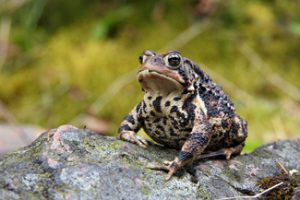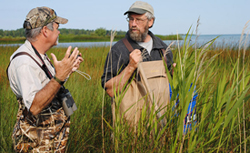 “It’s in the woods, is surrounded by some impressive swamp white oaks and has a grove of buttonbush growing in it. It’s also a breeding site for several species of woodland amphibians, including spotted salamanders and chorus frogs.” If you’d like to (1) visit this place (the chorus frogs may be calling) and (2) have a place like it on your own land yourself, sign up by May 27. (Photo: Western chorus frog, USFWS Headquarters.)
“It’s in the woods, is surrounded by some impressive swamp white oaks and has a grove of buttonbush growing in it. It’s also a breeding site for several species of woodland amphibians, including spotted salamanders and chorus frogs.” If you’d like to (1) visit this place (the chorus frogs may be calling) and (2) have a place like it on your own land yourself, sign up by May 27. (Photo: Western chorus frog, USFWS Headquarters.)
wetland management
Helping Mr. Toad come home
 You’re in luck — and being helpful — if your land has a wetland, says CFAES Wildlife Specialist Marne Titchenell. “Wetlands are rare habitats that many plants and animals depend on. Landowners who are willing to dedicate a portion of their land to a wetland are providing some much-needed homes for wildlife.” Learn more in a workshop she’s co-teaching June 3.
You’re in luck — and being helpful — if your land has a wetland, says CFAES Wildlife Specialist Marne Titchenell. “Wetlands are rare habitats that many plants and animals depend on. Landowners who are willing to dedicate a portion of their land to a wetland are providing some much-needed homes for wildlife.” Learn more in a workshop she’s co-teaching June 3.
In honor of World Wetlands Day …
Mazeika Sullivan and some of his students talk about CFAES’s Wilma H. Shiermeier Olentangy River Wetland Research Park in a video published last spring. The park, which is located in Columbus near Ohio State’s campus, is a Ramsar Wetland of International Importance. Sullivan, an associate professor in CFAES’s School of Environment and Natural Resources, is the park’s director. Today is World Wetlands Day.
Today is World Wetlands Day
 Feb. 2 marks the anniversary of the adoption of the 1971 Ramsar Convention for the conservation and wise use of wetlands. The convention focused on the conservation, education and importance of wetlands throughout the world. Wetlands provide a host of ecosystem services, including habitat for plant and animal species, flood control during storm events, water-quality improvement, and a food source for a large portion of the world’s population. The Ramsar Convention continues to promote wetlands and their ecosystem services and to approve the designation of sites around the world that serve as wetlands of international importance.
Feb. 2 marks the anniversary of the adoption of the 1971 Ramsar Convention for the conservation and wise use of wetlands. The convention focused on the conservation, education and importance of wetlands throughout the world. Wetlands provide a host of ecosystem services, including habitat for plant and animal species, flood control during storm events, water-quality improvement, and a food source for a large portion of the world’s population. The Ramsar Convention continues to promote wetlands and their ecosystem services and to approve the designation of sites around the world that serve as wetlands of international importance.
In 2008, the Wilma H. Schiermeier Olentangy River Wetland Research Park (ORWRP) became the 25th wetland of international importance in the U.S. and the first in Ohio. This designation was in recognition of the combination of different wetland and riverine habitats at the ORWRP; outreach and education on the importance of wetlands in an urban community; and high-quality university teaching and research pertaining to wetland ecology and management. We continue to build on this legacy with our research, teaching and outreach related to aquatic and riparian ecosystems.
For more information on the ORWRP, please visit our webpage at swamp.osu.edu or our Ramsar page at ORW Ramsar. For more information on World Wetlands Day, see worldwetlandsday.org.
ORWRP is part of CFAES’s School of Environment and Natural Resources. ORWRP director: Dr. Mazeika Sullivan (sullivan.191@osu.edu); facility manager: Brent Macolley (macolley.1@osu.edu). (Photo: iStock.)
Out of the classroom, into the field
 CFAES’s Bob Gates recently completed a summer faculty fellowship with the U.S. Fish and Wildlife Service. Based in the agency’s East Lansing, Michigan, field office, he focused on wetland conservation during the program’s six weeks. An associate professor of wildlife ecology, he’s pictured, left, with Denny Albert of USFWS in a marsh on northern Lake Michigan. Read the story. (Photo: Greg Soulliere, USFWS.)
CFAES’s Bob Gates recently completed a summer faculty fellowship with the U.S. Fish and Wildlife Service. Based in the agency’s East Lansing, Michigan, field office, he focused on wetland conservation during the program’s six weeks. An associate professor of wildlife ecology, he’s pictured, left, with Denny Albert of USFWS in a marsh on northern Lake Michigan. Read the story. (Photo: Greg Soulliere, USFWS.)
What plants and soils can tell us about the quality of a wetland
 “Extensive losses of wetland habitats and their unique communities are major environmental concerns,” says the flier for the next School of Environment and Natural Resources seminar. Martin Stapanian, research ecologist with the U.S. Geological Survey’s Lake Erie Biological Station (pdf), presents “Soil and Vegetation Indices for Wetland Quality: A Predictive Modeling Approach” from 4-5:30 p.m. Thursday, Oct. 31, on Ohio State’s Columbus campus, with a video link to the Wooster campus of CFAES’s research arm, OARDC. Free. Details.
“Extensive losses of wetland habitats and their unique communities are major environmental concerns,” says the flier for the next School of Environment and Natural Resources seminar. Martin Stapanian, research ecologist with the U.S. Geological Survey’s Lake Erie Biological Station (pdf), presents “Soil and Vegetation Indices for Wetland Quality: A Predictive Modeling Approach” from 4-5:30 p.m. Thursday, Oct. 31, on Ohio State’s Columbus campus, with a video link to the Wooster campus of CFAES’s research arm, OARDC. Free. Details.